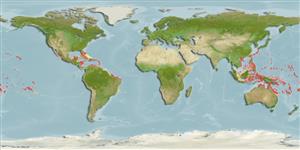Demospongiae |
Haplosclerida |
Chalinidae
Environment: milieu / climate zone / εύρος βάθους / distribution range
Οικολογία
Υφαλόφιλο(α); Υφάλμυρο; εύρος βάθους 1 - 6 m (Αναφ. 108813). Tropical
Pacific Ocean and Western Central Atlantic.
Length at first maturity / Μέγεθος / Weight / Age
Γεννητική Ωρίμανση: Lm ? range ? - ? cm
Thickly encrusting or massive with irregular, solid form. Raised thick-walled volcano-shaped oscules reaching several centimeters in height. Exterior is pale blue-green, while interior is dirty yellow in color. Soft and easily torn, even, slightly smooth surface similar to a fine sandpaper. Megascleres are bent oxeas, 170 to 230 micrometers and microscleres are sharply curved C-shaped sigmas about 25 micrometers.
Author and year from Ref. 3248. Mainly restricted to shallow-water fouling communities, dredged channels and artificial lagoons and also on the roots of the non-indigenous red mangrove, Rhizophora mangle (Ref. 3248).
Life cycle and mating behavior
Γεννητική Ωρίμανση | Αναπαραγωγή | Γεννοβολία | Eggs | Γονιμότητα | Larvae
Adults are capable of asexual reproduction via fragmentation, many are sequentially hermaphroditic. Sexual reproduction occurs by capturing sperm released into the water by adjacent individuals and transporting it to the egg deep with in the aquiferous system.
DeFelice, R.C., L.G. Eldredge and J.T. Carlton 2001 Nonindigenous marine invertebrates. p. B-i-B-60. In Eldredge, G.L. and C.M. Smith. A Guidebook of Marine Species in Hawaii. Bishop Museum Technical Report 21. (Αναφ. 3248)
IUCN Red List Status
(Αναφ. 130435: Version 2025-1)
CITES status (Αναφ. 108899)
Not Evaluated
Not Evaluated
Threat to humans
Human uses
| FishSource |
Εργαλεία
Περισσότερες πληροφορίες
Τροφική ΟικολογίαFood items (preys)
Σύσταση δίαιτας
Κατανάλωση τροφής
Θηρευτές
Population dynamicsΑύξηση
Max. ages / sizes
Length-weight rel.
Length-length rel.
Length-frequencies
Mass conversion
Αφθονία
Life cycleΑναπαραγωγήΓεννητική ΩρίμανσηΓονιμότηταΓεννοβολίαEggsEgg developmentLarvae PhysiologyΚατανάλωση οξυγόνου
Human RelatedStamps, coins, misc.
Διαδικτυακές πηγές
Estimates based on models
Preferred temperature
(Ref.
115969): 26.6 - 29.2, mean 27.7 (based on 949 cells).
Price category
Unknown.
